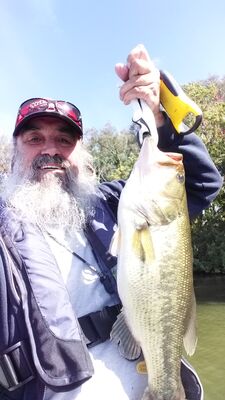Water Temperature for SoCal
California Fishing
Apr 6, 2024 13:45:18 #
Shellback_USNRET
Loc: Southern California
Good info..
https://waterdata.usgs.gov/monitoring-location/11044000/#parameterCode=00010F&period=P7D&showMedian=false
Temps below 32 degrees Ice.
33-42 degrees Do not expect fish to feed. Warmwater fish are too sluggish, trout feeding is minimal.
43-48 degrees Macrophytic aquatic plants are dead.
49-55 degrees Bluegill will feed, especially if conditioned to fish food pellets. Peak trout feeding temperatures.
56-58 degrees Channel catfish come to life, and begin searching for food. Bluegill activity escalates, Bass begin moving from structure. Trout active.
59-62 degrees Bass begin showing signs of nesting, preparing crater-shaped spots, 4-6 feet deep, 18 inches in diameter, for spawning. Trout still active and growing. Crappie on nests.
63-68 degrees World-wide, this is prime spawning temperatures for largemouth bass. Redear sunfish and bluegill begin preparing and sitting on nests. Trout active and growing.
69-72 degrees "1. The largemouth seems most comfortable when the water is between 65° and 75°.
2. The bass spawn wanes, with schools of baby bass beginning to appear. Bluegill are on nests. All fish feeding well."
73-76 degrees "Peak operating temperatures for all warm water fish. Heavy feeding, both natural food and from your feeders. Young of the year bass, bluegill and redear can be
observed. Channel catfish beginning their spawning rituals. Trout tend to become sluggish."
77-80 degrees Trout are dead. Warm water fish on full feeding throttles, growth rates max.
81-84 degrees "1. Bass become uncomfortable when the water temperatures rise above 80°.
2. Warm water fish are active. By now, baby fish hatched in the lake are reaching fingerling sizes, and clear water makes forage fish available to bigger predator fish.
3. Bass will be found along shaded or windy shorelines where wave action pumps oxygen into the water, where an oxygenated spring enters a lake, or among aquatic plants which produce oxygen. "
85-88 degrees "Biological activity, especially microbes, in water, reaches most rapid life cycle movement in warmer water. Fish metabolism beginning to slow, growth rates
reaching summer doldrums."
89-92 degrees Even warmwater species begin to hunker down in their "survival" mode. Limited feeding times, fish get sluggish.
Above 93 degrees Drink lots of fluids. Oxygen depletions are most common.
https://waterdata.usgs.gov/monitoring-location/11044000/#parameterCode=00010F&period=P7D&showMedian=false
Temps below 32 degrees Ice.
33-42 degrees Do not expect fish to feed. Warmwater fish are too sluggish, trout feeding is minimal.
43-48 degrees Macrophytic aquatic plants are dead.
49-55 degrees Bluegill will feed, especially if conditioned to fish food pellets. Peak trout feeding temperatures.
56-58 degrees Channel catfish come to life, and begin searching for food. Bluegill activity escalates, Bass begin moving from structure. Trout active.
59-62 degrees Bass begin showing signs of nesting, preparing crater-shaped spots, 4-6 feet deep, 18 inches in diameter, for spawning. Trout still active and growing. Crappie on nests.
63-68 degrees World-wide, this is prime spawning temperatures for largemouth bass. Redear sunfish and bluegill begin preparing and sitting on nests. Trout active and growing.
69-72 degrees "1. The largemouth seems most comfortable when the water is between 65° and 75°.
2. The bass spawn wanes, with schools of baby bass beginning to appear. Bluegill are on nests. All fish feeding well."
73-76 degrees "Peak operating temperatures for all warm water fish. Heavy feeding, both natural food and from your feeders. Young of the year bass, bluegill and redear can be
observed. Channel catfish beginning their spawning rituals. Trout tend to become sluggish."
77-80 degrees Trout are dead. Warm water fish on full feeding throttles, growth rates max.
81-84 degrees "1. Bass become uncomfortable when the water temperatures rise above 80°.
2. Warm water fish are active. By now, baby fish hatched in the lake are reaching fingerling sizes, and clear water makes forage fish available to bigger predator fish.
3. Bass will be found along shaded or windy shorelines where wave action pumps oxygen into the water, where an oxygenated spring enters a lake, or among aquatic plants which produce oxygen. "
85-88 degrees "Biological activity, especially microbes, in water, reaches most rapid life cycle movement in warmer water. Fish metabolism beginning to slow, growth rates
reaching summer doldrums."
89-92 degrees Even warmwater species begin to hunker down in their "survival" mode. Limited feeding times, fish get sluggish.
Above 93 degrees Drink lots of fluids. Oxygen depletions are most common.
Apr 6, 2024 14:06:20 #
Shellback_USNRET wrote:
Good info.. br br https://waterdata.usgs.gov/moni... (show quote)
Thanks Shellback, I'll copy this and adapt it to my location.


Apr 6, 2024 14:44:47 #
Shellback_USNRET wrote:
Good info.. br br https://waterdata.usgs.gov/moni... (show quote)
Thanks Shell, great info
Apr 6, 2024 20:07:42 #
Apr 7, 2024 10:59:28 #
Apr 7, 2024 11:50:02 #
Apr 7, 2024 18:13:03 #
Jer
Loc: N. Illinois 🇺🇸
Shellback_USNRET wrote:
Good info.. br br https://waterdata.usgs.gov/moni... (show quote)
Really good to know. Thanks.
If you want to reply, then register here. Registration is free and your account is created instantly, so you can post right away.

